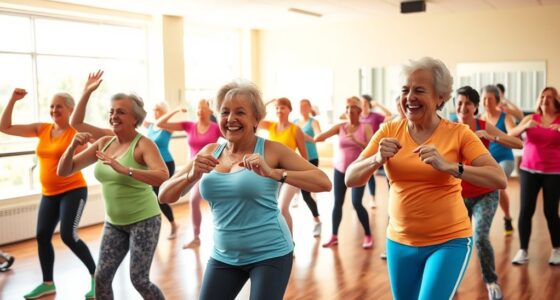Regular exercise is essential for staying healthy at any age. It boosts your physical and mental well-being, reduces the risk of chronic diseases, and enhances your mood. Aim for at least 150 minutes of moderate-intensity aerobic activity each week, along with muscle-strengthening and balance exercises. Incorporate fun activities to keep you motivated. By making exercise a priority, you’ll enjoy better health and independence. Keep going to discover more tips to enhance your fitness journey!
Key Takeaways
- Regular exercise improves physical and mental health, reducing the risk of chronic diseases and enhancing overall quality of life for seniors.
- Aim for at least 150 minutes of moderate-intensity aerobic activity weekly, along with muscle-strengthening exercises on two or more days.
- Incorporate balance and flexibility exercises, such as tai chi and stretching, to prevent falls and enhance range of motion.
- Stay hydrated to support physical activity, cognitive function, and recovery during exercise routines.
- Make exercise enjoyable by engaging in group activities, games, and creative routines to maintain interest and motivation.
Importance of Regular Exercise for Seniors
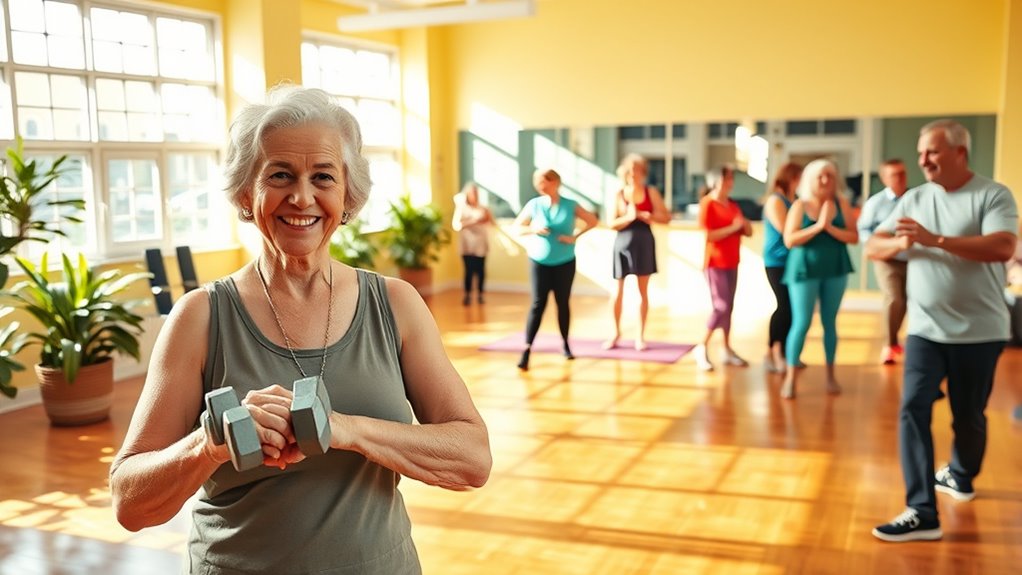
Regular exercise is essential for seniors, as it can greatly enhance both physical and mental well-being. Engaging in regular exercise considerably improves health by reducing the risk of chronic diseases like heart disease and type 2 diabetes. Additionally, strong communication skills during group activities can foster social connections and support networks, which are beneficial for mental health. It also boosts mental health, lowering the risk of depression and anxiety while enhancing cognitive function. For older adults, maintaining muscle strength and coordination through physical activity is crucial; it can reduce the risk of falls by 23%. Furthermore, individuals with a history of BPD traits may find that regular exercise positively impacts their emotional regulation. Incorporating regular physical activity can also help improve audiometric testing results by promoting better overall health. By aiming for at least 150 minutes of moderate aerobic activity weekly, you’ll not only strengthen muscles and bones but also improve flexibility. Additionally, critical periods in life highlight the importance of establishing healthy habits, which can significantly impact overall well-being. Incorporating data-driven decision-making into exercise routines, such as tracking progress and adjusting activities, can further enhance motivation and outcomes. Ultimately, regular exercise enhances your quality of life, allowing you to remain independent and active in daily activities.
Types of Physical Activities for Older Adults
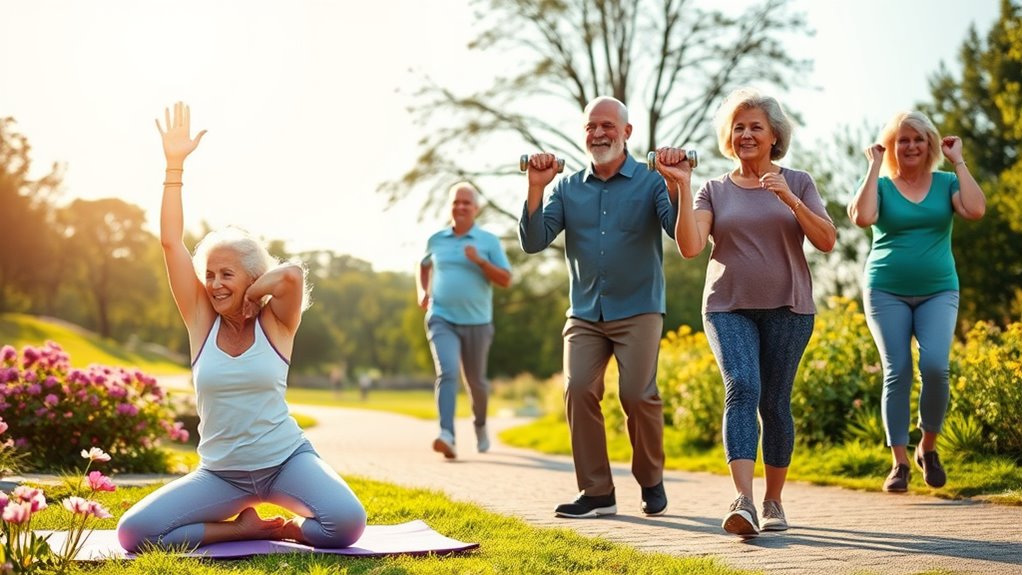
When considering the types of physical activities suitable for older adults, it’s important to recognize the variety of options available that cater to different fitness levels and preferences.
Engaging in regular exercise can enhance your overall health and well-being. Here are some effective activities:
- Aerobic Activity: Aim for at least 150 minutes of moderate-intensity activities, like brisk walking or swimming, each week to boost cardiovascular health. Incorporating nutritious breakfast options can also support your energy levels for these activities. Additionally, participating in balance exercises can further improve stability and reduce the risk of falls. Regular exercise can also play a role in managing behavioral issues that may arise in older adults. Furthermore, maintaining a structured routine can help older adults stay motivated and committed to their exercise regimen.
- Strength Training: Incorporate exercises focusing on major muscle groups at least twice a week to maintain muscle mass and bone health.
- Balance Exercises: Practice tai chi or simple standing on one leg regularly for falls prevention and improved stability.
Incorporating flexibility exercises, such as stretching or yoga, also helps enhance your range of motion and comfort in daily activities. Additionally, maintaining a regular review of your exercise routine can help you stay motivated and adjust your activities as needed.
Recommended Exercise Guidelines
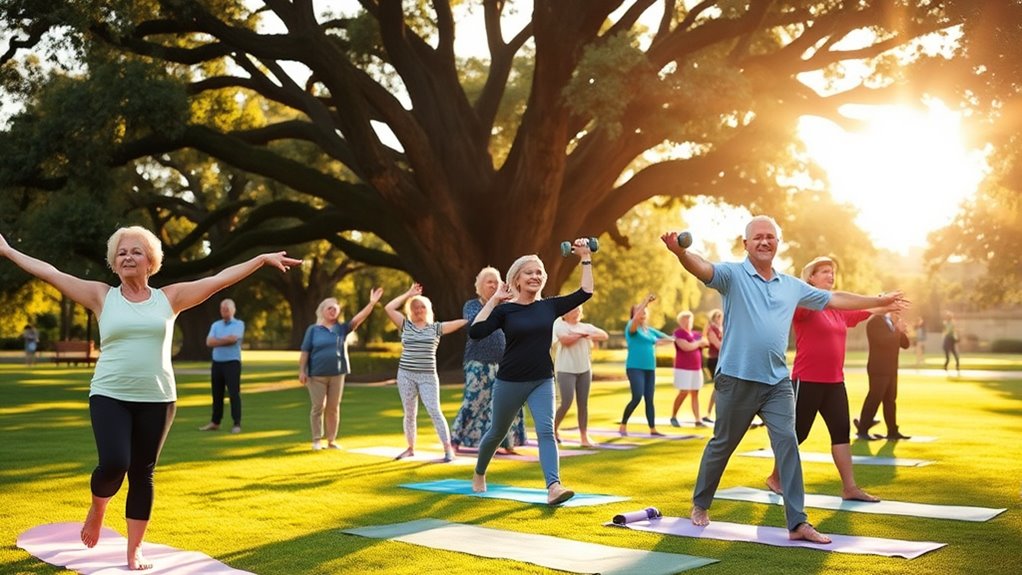
To maintain ideal health as you age, it’s vital to follow exercise guidelines tailored for older adults. Aim for at least 150 minutes of moderate-intensity aerobic activity or 75 minutes of vigorous activity each week. Additionally, engaging in muscle-strengthening activities on two or more days to focus on major muscle groups and prevent muscle loss is essential; this can help mitigate the effects of muscle loss that often occurs with aging. Incorporating balance and flexibility exercises is essential; these can notably reduce your risk of falls and improve mobility. You can break exercise sessions into manageable 10- to 15-minute increments throughout the day to meet your goals. Furthermore, maintaining a healthy indoor environment with air purifiers can enhance respiratory health, supporting your overall well-being during physical activities. Consider adding large indoor plants to your space, as they can improve air quality and provide a calming atmosphere. Engaging in regular physical activity also contributes to mental health by reducing the risk of depression and anxiety in older adults. Before starting any new exercise program, consult your healthcare provider, especially if you have existing health concerns. Your health and safety should always come first. Furthermore, consider exploring retirement savings options that can provide financial stability as you maintain an active lifestyle.
Benefits of Strengthening and Stretching Exercises
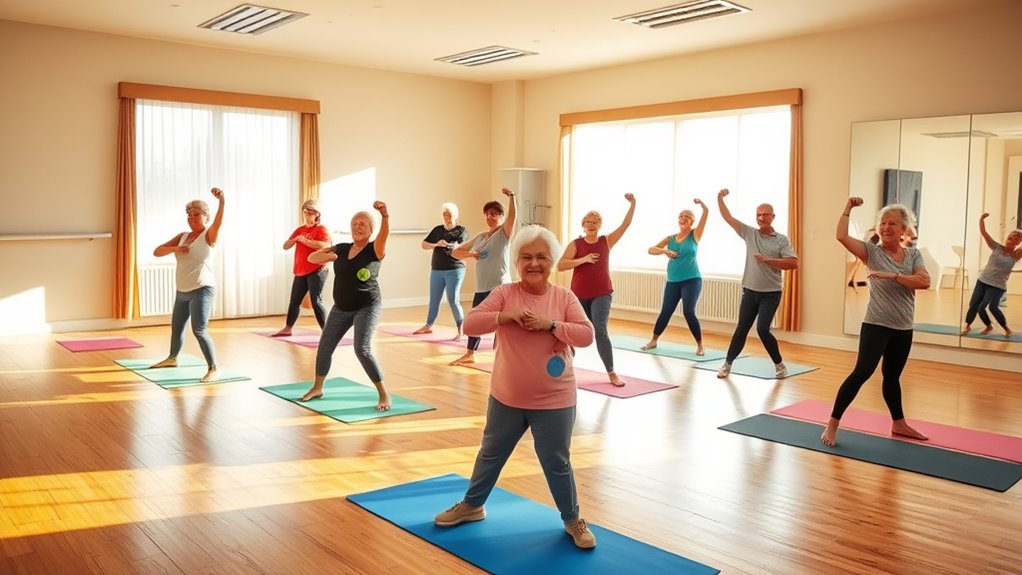
Strengthening and stretching exercises offer a multitude of benefits that can greatly enhance your quality of life as you age. By incorporating these exercises into your routine, you can improve your strength, increase flexibility, and support overall health and wellness.
- Strengthening exercises help prevent muscle and bone mass loss, essential for reducing your risk of osteoporosis and fractures. Additionally, knowing the local business hours of fitness centers can help you stay consistent with your workouts. Regular strength training also promotes mental clarity, which is crucial for maintaining focus and decision-making as you age. Moreover, maintaining proper absorbed fixed overhead costs in your fitness budget can ensure you have access to necessary resources for your workouts.
- Stretching exercises improve flexibility and range of motion, making daily activities easier and more comfortable.
- Engaging in these activities regularly can enhance physical function and alleviate stiffness, reducing the likelihood of back pain.
- Additionally, a balanced exercise routine can play a role in reducing anxiety and depression symptoms for older adults, contributing to overall emotional well-being.
Together, these exercises foster a balanced routine that not only boosts your physical health but also enhances your ability to stay active and independent.
Activities to Enhance Balance and Prevent Falls
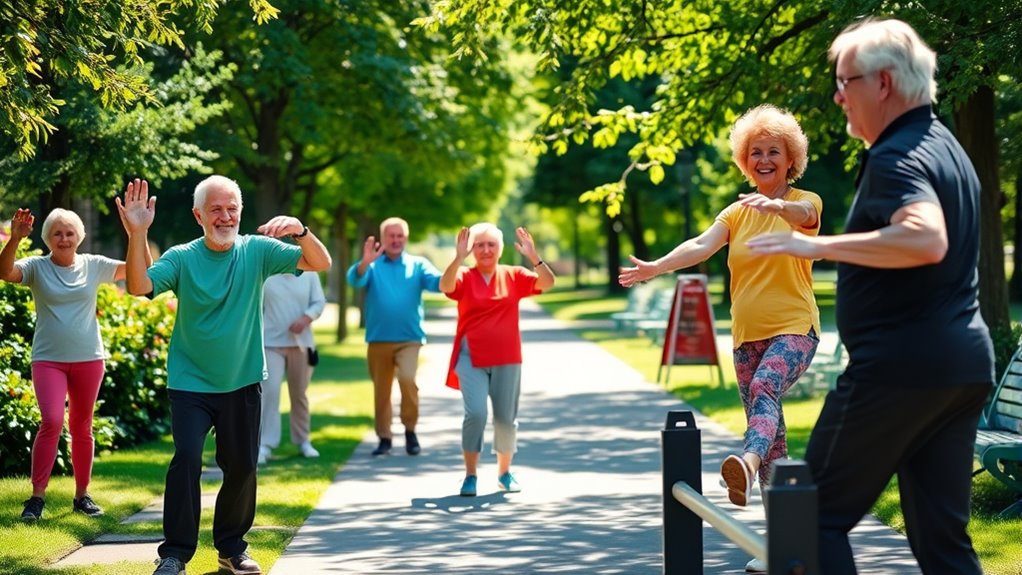
Incorporating balance exercises into your routine is just as important as strengthening and stretching. These activities can greatly enhance stability and coordination, helping you prevent falls. Simple exercises like weight shifting and standing on one leg can easily fit into your daily routines. Using a sturdy chair for support boosts your confidence while you practice. Regular grooming can also help reduce shedding significantly in your pets, allowing for a cleaner home environment. Engaging in these exercises not only supports secure attachment bonds but also fosters a sense of connection and well-being. Additionally, incorporating educational toys that promote physical activity can enhance your overall fitness. Research shows that hydration is crucial for maintaining optimal brain function, which can further support your physical activities.
| Exercise Type | Description |
|---|---|
| Weight Shifting | Shift your weight from one leg to another. |
| Single-Leg Balance | Stand on one leg, holding onto a sturdy chair. |
| Tai Chi | Practice slow, controlled movements. |
| Heel-to-Toe Walk | Walk in a straight line, placing heel to toe. |
| Side Leg Raises | Lift one leg to the side to improve stability. |
Regular practice not only enhances mobility but also improves your quality of life. Engaging in sensory stimulation activities can further support your overall health and well-being.
Frequently Asked Questions
What Type of Exercise Is Best for Older Adults?
The best type of exercise for you includes a mix of aerobic activities, strength training, flexibility, and balance exercises.
Aim for at least 150 minutes of moderate-intensity activity each week. You might enjoy walking, swimming, or cycling for cardio.
Incorporate strength training twice a week with bodyweight exercises or light weights, and don’t forget stretching and balance work, like tai chi, to enhance your overall fitness and prevent falls.
Always consult a healthcare provider first.
How Does Regular Exercise Help Older Adults Stay Healthy?
You might think that staying active is too hard or risky, but regular exercise can actually transform your health.
It strengthens your heart, reduces the risk of chronic diseases, and boosts your mood. By committing to just 150 minutes of aerobic activity weekly and incorporating strength training, you’ll not only build muscle but also enhance balance, making falls less likely.
Ultimately, exercise can elevate your quality of life, helping you feel vibrant and engaged.
Which Type of Exercise Is Most Strongly Recommended for Older Adults?
The most strongly recommended type of exercise for you is a combination of aerobic activity, strength training, balance exercises, and flexibility work.
Aim for at least 150 minutes of moderate aerobic activity weekly, plus strength exercises two days a week.
Incorporate balance activities, like tai chi, to reduce fall risk, and stretch daily to improve flexibility.
This holistic approach helps you maintain overall health and enhances your quality of life as you age.
How to Keep the Elderly Active?
“An apple a day keeps the doctor away.”
To keep the elderly active, encourage them to engage in activities they enjoy, like gardening or dancing.
Aim for 150 minutes of moderate exercise weekly, broken into manageable 10-15 minute sessions. Incorporate strength and balance exercises at least twice a week.
Light household chores can also help keep them moving.
Always remind them to check with their healthcare provider before starting any new routine.
Conclusion
In the dance of life, staying active is your ticket to a vibrant performance at any age. Embrace the rhythm of regular exercise, and you’ll not only strengthen your body but also boost your spirit. Whether you’re stretching, strengthening, or finding your balance, each step keeps you nimble and ready to seize the day. So lace up those sneakers and take charge of your health—it’s never too late to waltz into a healthier, happier you!





